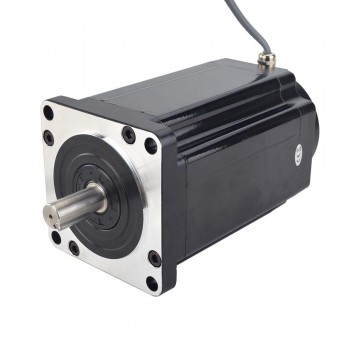1.Overview of three-phase stepper motor
The three-phase stepper motor is an actuator that converts electrical pulse signals into angular displacement. It has the advantages of simple structure, convenient control, high precision, and no cumulative error. It is widely used in automation equipment such as CNC machine tools, robots, printers, scanners, etc.
2.Speed regulation principle of three-phase stepper motor
Speed regulation refers to changing the speed of the motor to meet different working requirements. The speed regulation of three-phase stepper motors is mainly achieved in the following two ways:
1.Pulse frequency speed regulation: By changing the pulse frequency input to the motor driver, the speed of the motor can be changed. The higher the pulse frequency, the faster the motor speed.
2.Current control speed regulation: By adjusting the current in the motor winding, the torque of the motor can be changed, thereby affecting the speed. The larger the current, the greater the torque and the faster the speed.
3.Speed regulation method of three-phase stepper motor
1.Microstep control: By subdividing the step angle of the motor, more precise control can be achieved. For example, subdividing the step angle of 1.8 degrees into 0.9 degrees can improve control accuracy and smoothness.
2.PWM control: Use pulse width modulation (PWM) technology to adjust the current size in the motor winding to achieve smooth speed regulation.
3.Vector control: By controlling the direction and size of the motor's magnetic field, efficient and accurate speed regulation is achieved.
4.Current chopping control: By adjusting the on and off time of the current, the motor speed is controlled.
5.Hybrid control: Combine the above control methods to achieve better speed regulation performance.
4.Implementation steps of three-phase stepper motor speed regulation
1.Determine the speed regulation requirements: According to the application scenario, determine the required speed regulation range and accuracy.
2.Select a suitable driver: According to the motor parameters and speed regulation requirements, select a suitable stepper motor driver.
3.Design control circuit: Design a suitable control circuit to achieve control of the motor driver.
4.Write a control program: According to the control requirements, write a control program to achieve precise control of the motor.
5.Debug and optimize: Through actual operation, debug and optimize the control parameters to achieve the best speed regulation effect.
Three-phase stepper motor speed regulation technology has a wide range of applications and prospects in the field of automation. By choosing the appropriate speed regulation method and control strategy, the motor can be precisely controlled to meet the needs of different scenarios. With the continuous advancement of control technology, the speed regulation performance of three-phase stepper motors will be further improved, providing a stronger driving force for the development of automation equipment.





No comments:
Post a Comment